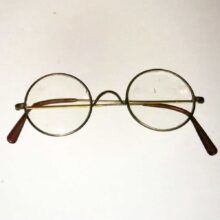Swedish physician, Frithiof Holmgren, developed a means to test color vision and tested the entire staff of the Swedish railway. Holmgren surprised officials by finding almost 5% percent were colorblind. Sweden promptly passed laws requiring vision testing for all its rail workers. In the U.S., only a few states passed such laws, but many railway managers took action. Ophthalmologist,John Weeks reported in 1894 that two-thirds of the railroads serving New York City had voluntarily adopted such programs.
Holmgren’s original test required subjects to match colors among 150 objects such as squares of colored paper or skeins of yarn. Other physicians developed other testing methods, including using colored lights or flags to reproduce conditions on railroads. The railroads needed a quick and efficient test that did not need a physician to test every rail employee.
When the Pennsylvania Railroad began system-wide color vision testing in 1880, Dr. William Thomson was selected to develop a solution. Dr.Thomson simplified Holmgren’s test into a set of 40 standardized, numbered skeins of colored yarn attached to a ruler-like board, which became known as Thomson’s Stick. The examiner handed the subject a sample of yarn and asked him to choose from the stick other yarns similar in color. The examiner recorded the numbers of the colors the subject chose. Railroad supervisors could administer the test after minimal training, and each test required only two to three minutes. Those who passed the test required no additional study. Employees who did not pass were referred to the railway surgeon for retesting and further evaluation. This allowed the doctors to focus on the small number of employees with questionable results, without having to spend time examining the vast majority who had normal color vision. The railway surgeon could tell which colors the employee had chosen by reviewing the numbers on the test record, often making a preliminary diagnosis even before examining the employee. Initial tests on the Pennsylvania showed 4.2 percent of employees to have color vision.
Color test modified by Dr. William Thomson.
Eye Exam Equipment, Museum





